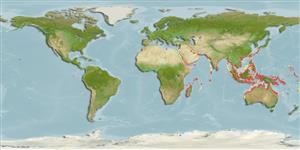>
Beloniformes (Needle fishes) >
Belonidae (Needlefishes)
Etymology: Strongylura: Greek, strongylos = round + Greek, oura = tail (Ref. 45335).
Environment: milieu / climate zone / depth range / distribution range
Ecología
marino; salobre; rango de profundidad 5 - 25 m (Ref. 122660). Tropical; 30°N - 27°S
Indo-West Pacific: Persian Gulf eastward along the coasts of Pakistan, India, and Sri Lanka, then extending to southern China, the Philippines, and northern Australia. A record from Zanzibar (Tanzania) needs confirmation.
Tamaño / Peso / Age
Maturity: Lm ? range ? - ? cm
Max length : 40.0 cm SL macho / no sexado; (Ref. 4833); common length : 22.0 cm SL macho / no sexado; (Ref. 9682)
Espinas dorsales (total) : 0; Radios blandos dorsales (total) : 12 - 15; Espinas anales: 0; Radios blandos anales: 15 - 18; Vértebra: 59 - 65. Round in cross section. Dorsal fin rays 12-15; anal fin rays 15-18. Caudal peduncle without lateral keels. Caudal fin rounded or truncate. Predorsal scales few and relatively large, 100-130. Caudal fin light with a prominent round black spot near its base. Dorsal fin lobe and distal margin of caudal fin yellow in live adults, anterior margin of anal fin orange.
Found in coastal areas and mangrove-lined lagoons, also enters freshwater. Carnivorous. Feeds mainly on small fishes, especially clupeoids. Occurs at temperatures ranging from 26 to 29°C (Ref. 4959). Oviparous (Ref. 205). Eggs may be found attached to objects in the water by tendrils on the egg's surface (Ref. 205). Sold fresh in markets.
Life cycle and mating behavior
Madurez | Reproducción | Puesta | Huevos | Fecundidad | Larva
Collette, B.B., 1984. Belonidae. In W. Fischer and G. Bianchi (eds.) FAO species identification sheets for fishery purposes. Western Indian Ocean (Fishing Area 51), Volume 1. FAO, Rome. (Ref. 3130)
IUCN Red List Status (Ref. 130435: Version 2024-2)
Threat to humans
Harmless
Human uses
Pesquerías: comercial
Herramientas
Special reports
Download XML
Fuentes de Internet
Estimates based on models
Preferred temperature (Ref.
123201): 25.1 - 29.2, mean 28.5 °C (based on 2807 cells).
Phylogenetic diversity index (Ref.
82804): PD
50 = 0.5001 [Uniqueness, from 0.5 = low to 2.0 = high].
Bayesian length-weight: a=0.00102 (0.00055 - 0.00192), b=3.09 (2.93 - 3.25), in cm total length, based on LWR estimates for this species & Genus-body shape (Ref.
93245).
Nivel trófico (Ref.
69278): 4.2 ±0.73 se; based on food items.
Resiliencia (Ref.
120179): Alto, población duplicada en un tiempo mínimo inferior a 15 meses (Preliminary K or Fecundity.).
Fishing Vulnerability (Ref.
59153): Moderate vulnerability (39 of 100).
